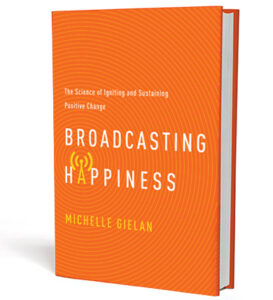Disrupt Negative Thinking and Revamp Your Broadcast
Do you know someone who is always negative?
Is it possible to inspire happiness in others?
Michelle Gielan, former national CBS News anchor turned positive psychology researcher, is the best-selling author of Broadcasting Happiness: The Science of Igniting and Sustaining Positive Change. She is the Founder of the Institute for Applied Positive Research.
I recently had the opportunity to ask speak with her about her fascinating research into happiness, positivity, and our impact on others.
Create Positive Change
You’ve been a successful broadcaster at CBS News. But your work now is about a different type of broadcasting. You say we broadcast happiness and that creates positive change in those around us. How did this realization come to you?
People talk about how negative the news can be—and they are right. As the anchor of two national news programs at CBS, I saw how not only were the stories largely negative but also told in a disempowering way. We rarely talked about potential solutions.
At the height of the recession, we started broadcasting solutions for every problem we featured. We called it Happy Week. Drawing on positive psychology, the series centered on actions taken to foster happiness (and quite frankly peace of mind!) during some of our biggest financial challenges.
We received the greatest viewer response of the year, but more importantly, this was a powerful example of research in action. I wanted to know more about creating empowerment in others—so I quit to study positive psychology at the University of Pennsylvania.
Now as a positive psychology researcher, I see the toxic effects of a constant stream of negative news on the brain. In a study I conducted with researcher Shawn Achor and Arianna Huffington, we found that watching just three minutes of negative news in the morning can lead to a 27% increased chance of you having a bad day as reported 6-8 hours later. The negative mindset we adopt first thing sticks with us all day.
But CBS News also showed me a better way—which is something I now share at talks at companies and organizations—specifically how to talk about the negative in a way that leaves people feeling empowered and ready to act. In our follow-up study published in Harvard Business Review, we found that by pairing a discussion of problems with solutions, you can fuel creative problem solving in someone else by 20%. For managers, this means you can talk about the negative without decimating your team.
Looking at all this research, I had an epiphany: we are all broadcasters. What’s your broadcast? As you move throughout your day talking to your colleagues, family and friends, where do you focus their attention? Some facts and stories fuel success; others don’t. In my book Broadcasting Happiness: The Science of Igniting and Sustaining Positive Change, I share the science and tools to disrupt negative thinking and revamp our broadcast to fuel success at work and beyond.
Using the science, our clients have been able to increase sales by 37%, productivity by 31%, and revenues by hundreds of millions of dollars. Personally, I’m so happy I now get to broadcast these kinds of stories about individuals and organizations creating positive change. This is so much more inspiring.
The Work Optimist, you point out, is five times less likely to burn out and three times more engaged than the pessimist. Is it possible to move up the continuum and be more positive? What techniques work to do this?
 Yes! The most inspiring thing about the results of our research is that many of the elements of our mindset that predict success, like Work Optimism, are malleable. Work optimism is the belief that good things can happen, especially in the face of challenges, and that our behavior matters. We created a validated assessment that tests people on their levels of Work Optimism and two other predictors of long-term success at work.
Yes! The most inspiring thing about the results of our research is that many of the elements of our mindset that predict success, like Work Optimism, are malleable. Work optimism is the belief that good things can happen, especially in the face of challenges, and that our behavior matters. We created a validated assessment that tests people on their levels of Work Optimism and two other predictors of long-term success at work.
If you find you’re scoring lower than you wish on Work Optimism, you can adopt a simple 30 second habit: Use the Power Lead. Make sure your lead sentence in conversations or meetings at work is positive. If you start conversations with how tired, sick, or stressed you feel, your body follows, as does the rest of the conversation.
We are taught to mimic the social patterns of others, so if someone starts a sales call with, “I’ve been swamped lately,” then both individuals start to feel more stressed and overwhelmed, which can oftentimes kill the sale. In our fast-paced world, you might have time to relay only one piece of social information at work. If you make it negative, then you get stuck in that pattern. Power leads can be simple, such as answering “How are you?” with some good news, such as, “Doing great! Had an awesome weekend with the family. My daughter scored a goal at lacrosse!”
What are a few ways to become a better broadcaster, able to motivate and communicate with power and results?
Central to being a positive broadcaster is seeing your power in the first place, no matter your level within your organization. I recently shared my research at Microsoft and asked, “How many of you have been told you can’t change other people?” The entire room raised their hands. And it happens all the time. But this thought is not only disempowering, it is scientifically false.
My favorite study showing how quickly we influence others was done at the University of California Riverside. Imagine being asked to sit in a room for two minutes with two strangers—in silence. Awkward! That’s what researchers did with multiple groups of threes, testing their moods before and after they went into the room.
Without fail, the most non-verbally expressive person influenced the moods of the other two people in the room significantly. If that person was nervous or had a frown, he or she made others feel more stressed. Meanwhile, someone smiling and relaxed had a positive effect on the others. Imagine what you could do with more time. Change your broadcast, change your power.
Let’s talk about the realist. How do you know whether the realist is realistic or just negatively impacting the overly enthusiastic optimist?
Great question. My husband and fellow researcher, Shawn Achor, is very funny. Most people would say that, too, after seeing his TED talk. And he always comes back from talks with the best stories.
One time he told me a CEO came up to him after his talk, saying he loved the research we’ve been doing. He wanted to give Shawn a ride to the airport so they could talk more about bringing it to his company.
Shawn got in the car and put on his seatbelt. The CEO didn’t. After a while the bell goes off reminding him. Shawn, thinking he’s making a joke, turned to the CEO and said, “Oh, you don’t wear seatbelts?” The CEO said, “No, man, I saw your talk! I’m an optimist!” Shawn thought to himself, “No, man, you’re an idiot.”
Optimism doesn’t stop cars from hitting us. The true optimist puts on his seatbelt because he believes his behavior matters. The true pessimist doesn’t because he thinks he’ll die anyway. If they are rational, both optimists and pessimists see reality—they just have completely different takes on what they can do about it.
The “reality” is that there is no such thing as a realist vs. an optimist. They are not opposites. Often the realist is actually a pessimistic or marginally optimistic person saying they are being more realistic to reign in the excitement of a highly optimistic person.
Lead to the Positive
I love your take on leading questions. Would you share just a highlight or two on this?
Leading questions help lead other people not to a specific answer but to positive territory. Do you have a colleague or kid that is habitually negative? Start asking them positive leading questions such as:
“What was the best part of your day?”
“What was the coolest thing you learned during that project/at school today?”
“Has anyone at work/school made your day better recently and how?”
If you’re a manager, you can start off meetings with five minutes of positive guided conversation. Pose a leading question and see where it takes the team. It’ll most likely give everyone a boost and connect them more deeply.
How to Deal with the Negative and Cynical
What techniques work when dealing with the truly negative or cynical?
Power leads and leading questions are my top two go-to methods because they are quick and easy—and we are socialized to reciprocate other people’s moods. If the person you’re talking to is still stuck in a negative mindset, limit exposure and make sure your positive resources are bolstered by getting your brain to focus on the fueling aspects of your day. That way their negativity won’t weigh on you as much.
Snap the Positive Picture
I’ve heard of the gratitude journal, but not snapping the positive picture. Does it work on the same principle?
Yes, many of us, including myself, are visual people, and snapping one positive meaningful picture each day can shift our thinking and make us more optimistic. We recommend taking one new and different picture each day for 21 days of something that makes you feel joy or gratitude—your kids playing with Playdough, a beautiful sunset, or your sweaty self after a run outside. Add them to a special album on your phone to look at when your boss is driving you nuts. I promise it’ll help!
How is technology and social media changing or impacting the way we broadcast?
Your feed can influence you greatly. In a study of 689,000 Facebook users, researchers from Cornell University found that changing a feed to be more negative increased the chances of people broadcasting negative posts to their network. The same was true for the positive. You are what you eat, and the same holds true for social media.
Meanwhile, a study on the New York Times most emailed list found when given a choice, people are significantly more likely to share positive stories over negative ones. My two suggestions based on this research are to hide overly negative people from your feed and be mindful about the tone of your posts.
Tell us a little about your latest research and your new program airing on PBS.
Shawn and I bust the myth that you can’t change other people, and we provide five tools to help people change their conversations to change others. The program is called INSPIRE HAPPINESS, and it looks at how to move other people from feeling insecure to feeling empowered, negative to positive, and from stuck to taking action. The thinking goes that the happier you make the people around you, the easier it is for you to be happy, too.
What’s it like to be a married pair of happiness researchers? How does that affect your marriage?
When Shawn and I had our son Leo, people asked us, “So, is he going to be the happiest baby in the world?” No pressure there!! Ha!
We have our moments like all couples. The difference I think is that since we know the research, we are getting better each day at recognizing when we are not living it, and we have the tools to more quickly get back to a positive place.
We practice happiness every day. It has become habit to praise each other for the small ways we’re helping around the house. We end our bedtime routine with our son by asking him and sharing our favorite moments of the day. He is almost three, so it’s very often something revolving around playing with trucks.
Based on these simple habits, we created a (free) Wake Up & Inspire Happiness Video Workshop, and we invite everyone to join us. It focuses on small ways you can change your personal broadcast to inspire happiness and success in others—making the choice of happiness easier for you at the same time. Those small shifts make a difference for us, and we hope they do the same for others.
Broadcasting Happiness: The Science of Igniting and Sustaining Positive Change


